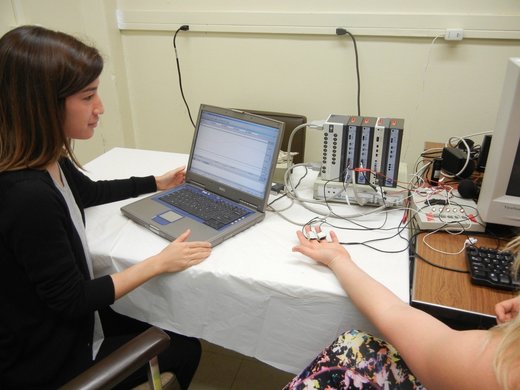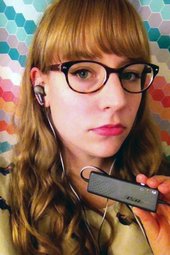
But for those with a rare, newly recognized disorder called misophonia, the mere thought of such a meal inspires only anxiety and dread. People with misophonia hate certain noises — termed "trigger sounds" — and respond with stress, anger, irritation and, in extreme cases, violent rage. Common triggers include eating noises, lip-smacking, pen clicking, tapping and typing.
All that chewing, chomping, slurping and clinking of silverware can drive a person with misophonia to avoid family gatherings altogether. And worse, feelings of aggression tend to be amplified if the sounds are coming from those with emotional ties to the sufferer, such as family members or significant others.
"I haven't eaten with my parents, at least without earplugs, in over a decade," said Meredith Rosol, a 25-year-old elementary school teacher from Baltimore who was diagnosed with misophonia two years ago after years of hypersensitivity to sound.
"I was 6 years old, and it started with my parents chewing at the dinner table," she recalled. Her list of triggers grew longer with every year: chewing (especially foods with crunch), tapping, typing, heavy breathing, silverware clinking, foot shuffling. Even certain sights started bugging her, such as foot-shaking and fidgeting. At school, typical classroom noises — like that of chalk scraping against the blackboard or the hum of a radiator — made her skin crawl.

The term misophonia, meaning "hatred of sound," was coined in 2000 for people who were not afraid of sounds — such people are called phonophobic — but for those who strongly disliked certain noises. Set off by stimuli that vary from person to person, the reaction, sufferers say, is like being sucker-punched in the gut or repeatedly stung by bees.
In 2013, a group of Dutch psychiatrists laid out the condition's diagnostic criteria and urged that it be classified as its own psychiatric disorder. (Misophonia is not currently in the American Psychiatric Association's Diagnostic and Statistical Manual of Mental Disorders, in part due to its being such a newly identified phenomenon.)
Even though misophonia is a new term, thousands of people have been describing its effects on them for years and joined such online support groups as Yahoo's Selective Sound Sensitivity Group and Reddit.com's misophonia subreddit. Rosol runs a misophonia meet-up group in Baltimore and maintains an Internet map where sufferers can post their location and contact information to find other people nearby with the condition.
No one knows what causes the condition, so designating a standard treatment has been problematic, but experts seem to agree that misophonia isn't so much about the sounds themselves as about their context.
Chewing sounds
"Sometimes their responses are localized around certain people: They might be bothered by their mother's chewing but not their brother's," said Miren Edelstein, a PhD student at the University of California at San Diego who has researched misophonia.
As part of a small study, Edelstein interviewed a number of self-identified misophonics and found that the fight-or-flight emotion arises only in specific circumstances. For instance, they didn't mind their own chewing or typing noises, or sounds made by animals or babies. A teacher of autistic children, Rosol said she doesn't usually get triggered by her students, even in the bustling cafeteria.
Edelstein and her colleagues also hooked up electrodes to volunteers' hands to verify that their aversion to certain sounds was real.
"Prior to our study, we only had anecdotal evidence that misophonia was a real thing," she said. "So we wanted to take the first step in providing objective physiological evidence."
Self-described misophonics listened to a series of sounds and rated their discomfort level for each one; so did volunteers who served as a control group. The electrodes measured the electrical conductance of their skin, a well-accepted measure of physiological arousal. Sweat glands in the hands are especially sensitive to emotional stimuli, and skin becomes a better conductor in the presence of more sweat.
When misophonics' discomfort ratings were high — say, during a sound bite of gum chewing or chip eating — their skin conductance shot up. But when they heard more-soothing sounds, such as rainfall, they did not have a sweat reaction. In other words, they aren't likely to be lying about having that sudden negative emotional response kick in.
But where does this intense reaction come from, if it's not caused by the noises alone?
"In my opinion, misophonia is a learned conditioned response," said audiologist Natan Bauman, owner of the Hearing, Balance and Speech Center, which has several locations in Connecticut. "If we associate a given event — in this case, all those trigger sounds — with something that is perceived to be a danger, then we need to act on it accordingly."
He has seen close to 100 misophonics in his private practice and doesn't believe misophonia is a hard-wired phenomenon. Rather, he thinks his patients at some point made a negative association with certain sounds, so negative that they have an impulsive reaction to them.
This impulse has to do with how the brain processes sound.
Sound waves cause tiny bones in the middle ear to vibrate. Hair cells inside the cochlea, a spiral-shaped cavity in the inner ear, transform the vibrations into electrical signals that travel down the auditory nerve to the brain.
The signal reaches the thalamus, a part of the brain that acts like a central switchboard for sensory information. From the thalamus, the signal follows two different paths to the amygdala, which is located deep in the brain and is involved in the processing of emotions such as fear and pleasure.
"Some people think the amygdala is mostly for fear-related emotion," said Josef Rauschecker, director of the Laboratory for Integrative Neuroscience and Cognition at Georgetown University. "The amygdala is a fairly old part of the brain, and our fears are pretty primordial, I would say."
One of the two routes is a direct pathway from the thalamus to the amygdala, enabling an immediate, unconscious response that leads to an emotional reaction. The advantage of this direct route is speed: You hear a loud bang, and fear prompts your body to rapidly and automatically jump.
The other route is longer and goes first to the medial prefrontal cortex before reaching the amygdala. The medial prefrontal cortex is a more evolutionarily advanced part of the brain that can regulate emotions and allow for a more discerning interpretation of a situation. The original signal splits and heads out on the two roads at the same time, but the signal traveling the longer route obviously takes longer to process.
"What happens with those who have misophonia, in my opinion, is that there is no involvement of this longer route, the more-refined route," Bauman said.
Cortex damage
Rauschecker agrees and speculates that misophonia might have something to do with damage to the medial prefrontal cortex, similar to what he found with another condition, tinnitus. Tinnitus is phantom ringing or other noise in the ear, a perception commonly caused by damaged hair cells in the cochlea.
"Say you go to a loud disco and you lose some hair cells," Rauschecker said. "The ringing lasts for a day or two, and then it disappears again."
The ear hasn't repaired itself. Rather, the medial prefrontal cortex can help tune out the phantom ringing. But for some people, the ringing never goes away. In 2006, Rauschecker and his colleagues found that tinnitus patients had significantly less volume in the medial prefrontal cortex than control participants without tinnitus.
"I would include misophonia as a subtype of tinnitus, probably," he said.
Regardless of its cause, misophonia makes life difficult for those who have it and for the people around them.
Those with extreme cases say they sometimes hole themselves up at home to avoid social situations and public places for fear of having something trigger a negative reaction.
A few treatment options do exist, but there is no cure. Bauman and other audiologists sometimes mix cognitive behavioral therapy and in-ear devices that emit white noise to drown out triggers. The hope is to reduce the white noise enough that the patient doesn't need to wear the device anymore; some patients have reached that point, Bauman says.
Rosol, whose sensitivity began when she was 6 years old and her parents chewing upset her, has found her own workarounds: a white-noise machine and earplugs in bed and noise-canceling headphones at the gym and on public transportation. At meals, she wears a single earplug and blocks the other ear with her hand when others start chewing loudly.
At Thanksgiving dinner this year, she used an earplug or two during the meal and specifically avoid sitting next to her parents. Because she can't hear what's being said, she usually doesn't contribute to the conversations.
"Thanksgiving isn't the easiest time," Rosol said. "I usually finish up earlier than everyone, go to the kitchen to clear my plate, and wait in another room."



Reader Comments
to our Newsletter